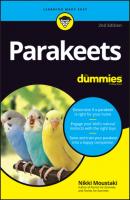Parakeets For Dummies. Nikki Moustaki
Чтение книги онлайн.

Читать онлайн книгу Parakeets For Dummies - Nikki Moustaki страница 5
Название: Parakeets For Dummies
Автор: Nikki Moustaki
Издательство: John Wiley & Sons Limited
Жанр: Биология
isbn: 9781119755302
isbn:
You’re one of the millions of people who wants a parakeet or who has a family member who wants one (or more) and you’ve come to this book to learn about their care and training.
You already have a parakeet, or two, or twenty, and you want to brush up on parakeet care and learn a few things that you don’t already know.
Maybe you’re a volunteer at a parrot shelter or rescue and you want to be able to educate your adopters more thoroughly.
Perhaps you want to begin breeding these popular little birds and want some information on how to make that process go smoothly.
Whatever the case, whether you’re a newbie or a seasoned parakeet guardian, there’s something in this book for you.
Icons Used in This Book
While reading Parakeets For Dummies, be on the lookout for these icons, sprinkled here and there:
Beyond the Book
You can find a little more parakeet-related on https://www.dummies.com/, where you can peruse this book's Cheat Sheet. To get this handy resource, go to the website and type Parakeets For Dummies Cheat Sheet in the Search box.
Where to Go from Here
Parakeets For Dummies is a reference, so you don’t have to read it in order from start to finish. Begin with Chapter 4 if you need basic set-up information, flip to Chapter 7 if you’re trying to learn parakeet-ese, or head to Chapter 2 if you’re still undecided about adding a parakeet to your family. (Although if you prefer to start at the beginning and read until you reach the back cover, you’re welcome to do so.)
Part 1
Introducing the Parakeet
IN THIS PART …
Finding out if a parakeet is perfect for you
Preparing to bring your parakeet home
Feeding your parakeet properly
Chapter 1
Parakeets: More Than Just Pretty, Whistling Birds
IN THIS CHAPTER
The word parakeet is a generic term for any smallish, slender bird in the parrot family that has a long, tapered tail. But when most people think “parakeet,” they think of the small, brightly colored bird common to most pet shops and to almost everyone’s childhood.
Parakeets are about 7 inches in length (with the English budgie at around 9 inches), and most of that length is taken up by the tail. This species, Melopsittacus undulatus, also called the budgerigar (budgie is its nickname), is found in large flocks in the grasslands of the Australian outback. The English budgie has the same Latin species name, even though it is much larger.
WHERE PARAKEETS COME FROM
Parakeets arrived in Europe around 1838, brought from Australia by British naturalist John Gould and his brother-in-law, Charles Coxen, who raised the first clutch (batch of babies). Europeans found that these birds were easy to breed, and wealthy people fell in love with them. They soon became popular in Germany, Belgium, France, and Holland.
A yellow mutation occurred in Belgium around 1875, leading to other color mutations, including olive, dark green, gray-green. Companion parakeets were simply green, as they are in the wild, until around 1881 when a Dutch bird keeper found a blue chick hatched in the nest boxes. This blue bird was responsible for other mutations: cobalt, mauve, slate, gray, and violet.
The parakeet arrived in America around the late 1920s, but didn’t become popular as a companion until the 1950s. Today, there are hundreds of color mutations and variations. Even so, the most common colors are the most popular: green, blue, yellow, and white.
The American Parakeet versus the English Budgie
Though the American parakeet and the English budgie both got their start in Australia, the American parakeet is more similar to its wild cousin than the English budgie. The English budgie is what hobbyists call an exhibition bird or a show budgie, because it is often shown in large budgie shows (kind of like dog shows, but for birds). It’s nearly twice the size of the American parakeet, and it claims its English name because the British, who received the exhibition size budgie from Western Europe, sent the exhibition budgie to America.
The English budgie is basically domesticated, which means that it has been changed from its wild form using selective breeding practices. This kind of selective breeding (choosing to breed only the animals that have desired traits so that the young will also have and pass on these traits to future generations) is what humans have done with dogs for thousands of years. (Notice how different dog breeds look so dissimilar from one another — it’s hard to imagine that they all originated from a couple of species of wild dog.) Though no parrot is truly domesticated, the English budgie is the closest.
Though technically called the budgie, the terms parakeet and budgie are interchangeable (see Figure 1-1). Some people call the larger version of the parakeet the budgie and the smaller version the parakeet — but it really doesn’t matter which term you use. For СКАЧАТЬ